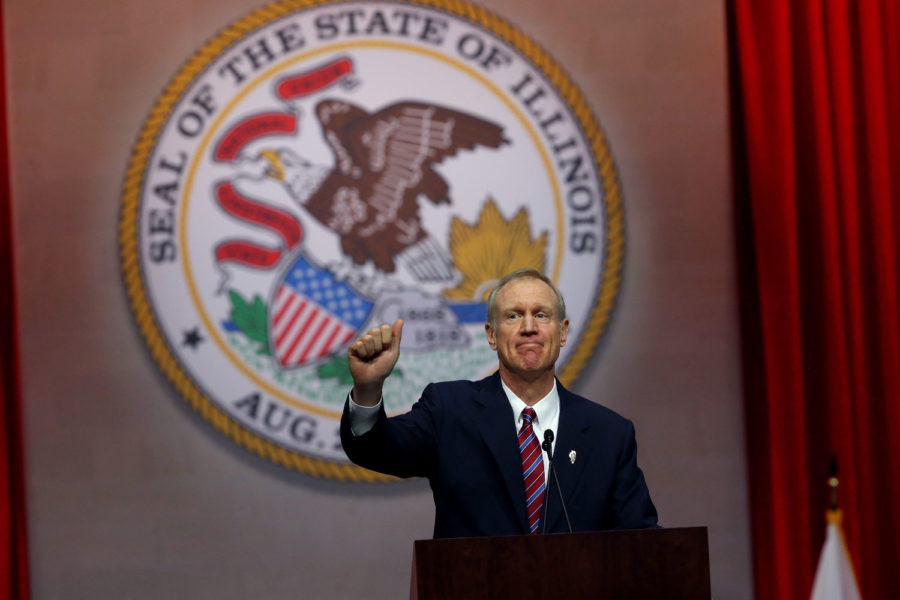Illinois public universities have fluctuating enrollment after difficult year
September 9, 2016
The University of Illinois announced Thursday its largest freshman class in history, but regional public universities statewide are facing steep enrollment declines this fall, with freshman classes down as much as 25 percent from last year.
Figures released this week, based on student enrollment on the 10th day of classes, come after the campuses spent the past year bracing for the possibility of lower numbers due to the state’s prolonged budget impasse.
While unable to pinpoint how much enrollment was affected by the budget uncertainty, several school leaders and state lawmakers said the financial mess — and the negative publicity surrounding it — surely had an effect. Illinois legislators and Gov. Bruce Rauner have failed to pass a spending plan for more than a year and universities have received only a fraction of their normal funding through emergency stopgap measures.
Advertisement
Schools with more secure finances, including U. of I. and Illinois State University, fared well while other institutions felt the pain of students avoiding schools they perceived as being on shakier grounds. Illinois universities already had been grappling for years with an increasing number of students leaving the state for college, drawn by competitive financial aid packages elsewhere.
Eastern Illinois University’s enrollment is down nearly 13 percent from last year, for example. The freshman class declined by 25 percent, to 1,251 students.
“A year ago, we celebrated a 2 percent increase in the number of first-time freshmen,” Eastern Illinois president David Glassman said in a statement. “We do have a proven strategy to grow our enrollments, and I’m positive that once the state budget issue is resolved we’ll resume that growth trajectory very quickly.”
Sen. Laura Murphy, D-Park Ridge, said she’s spoken with students who said they were “not even considering Illinois schools because nobody wants to put up with uncertainty.”
“It should be fixed quickly,” Murphy said of the state’s financial woes. “We have world-class universities, programs that are unique to the state of Illinois that should not be overshadowed by the budget issue.”
Most of the regional four-year universities had declines in undergraduate enrollment, including Southern Illinois University at Carbondale, which took one of the biggest hits.
More: SIU enrollment at lowest point since 1965, data shows
Advertisement*
Total enrollment at the Carbondale campus fell about 7.6 percent, to just fewer than 16,000 students. The university has 2,126 freshmen — 660 fewer than last year or a nearly 24 percent drop.
Spokeswoman Rae Morrow Goldsmith cited several reasons for the decline, including the financial situation as well as frequent staff turnover in the admissions office.
“We have fewer students than we would normally have coming in from out of state and we have a lot of evidence that students who were considering us as an in-state school went out of state because of lack of confidence by the state budget situation,” Goldsmith said.
SIU also had a decline in graduate students, which school leaders attributed to the reduction of graduate assistantships due to inadequate state funding. Enrollment at the university’s Edwardsville campus was down slightly.
Northern Illinois University also dropped in key areas, including a 5.5 percent dip in total enrollment to just more than 19,000.
The DeKalb campus has 457 fewer freshmen and about 1,000 fewer undergraduates on campus this fall, the latter marking a drop of 6.2 percent. Graduate enrollment also fell nearly 4 percent, to 4,672 students.
Western Illinois University had about the same number of freshmen as last year — 1,527 — but total enrollment declined 6.5 percent.
Ron Williams, WIU’s interim vice president of student services, said a strong recruitment push and tuition decrease helped with freshman enrollment and the retention of students to sophomore year.
“We were actually concerned earlier in the semester that we might be significantly down,” Williams said. “What’s important for us is that we recognized early on that recruitment and retention is everybody’s job. Western has recruitment plans for every academic program at the university.”
Bucking the statewide trend, University of Illinois’ three campuses logged their highest ever on-campus enrollment with just more than 77,000 students collectively, a 1.2 percent climb from a record set last fall. The Urbana campus drew its largest freshman class in institutional history, with nearly 7,600 students.
The campus also met its goal to increase the number of Illinois residents. About 74.6 percent of the freshman class is from the state, up from 73.1 percent last year, an increase of about 140 students. The number of international freshmen declined slightly but still makes up about 14 percent of the class.
Freshman enrollment at the University of Illinois at Chicago dropped 5.1 percent, a decline of almost 200 students from last year. The number of transfer students at the Chicago campus jumped by nearly 400, a 24 percent gain.
“Despite the headlines about the state budget impasse … students are flocking to our universities in record numbers,” U. of I. president Timothy Killeen told board members in a meeting Thursday at the Urbana-Champaign campus.
Illinois State University recorded a small increase of 1 percent in overall enrollment, including 3,638 freshmen, the largest class in nearly three decades.
“We’re not making huge leaps and bounds, but given that there are fewer students graduating high school and more fierce competition from universities out of state, to increase is really an accomplishment,” president Larry Dietz said.
ISU leaders said their finances allowed the Normal-based campus to weather the storm as the budget battle continued. Still, they said university staff had to ramp up recruitment in the past year, and the school’s gains do not mean they’ve emerged unaffected.
“I think that uncertainty did force more students out of state,” Dietz said. “They’re coming in to make a four-year commitment, they expect the institutions to make a four-year commitment back to them. We’re really not sure what the impact could have been. We possibly could have been up more, as could some other institutions throughout the state.”
Universities traditionally report their enrollment data after the 10th day of classes. Northeastern Illinois University, Governors State University and Chicago State University have not yet provided figures.
Sen. Bill Cunningham, a Chicago Democrat on the Senate’s higher education committee, said declining enrollment shouldn’t surprise anyone and placed blame squarely on the budget stalemate.
“Not only can I tell you that as a legislator but as a parent,” said Cunningham, whose daughter is a freshman at Illinois State.
“I know more than a few [students] were warned by their college counselors that perhaps the school they were looking at might not offer their major in a year or two,” he said, referring to universities cutting programs for financial reasons. “The General Assembly and the governor [are] forcing state universities to make very difficult decisions about what programs they keep.”
Sen. David Luechtefeld, also a higher education committee member, said he’s seen the effect of Illinois’ budget crisis on higher education and the competition from schools in nearby states.
“In my area, there are some options. You don’t have to go very far and you’re at another university … that seems more sound,” said Luechtefeld, a Downstate Okawville Republican. He’s seen the advertising of neighboring states’ universities target Illinois residents. Many also offer Illinois residents in-state tuition, he said.
“But what happened last year [with the state budget] really magnifies everything,” he said. “Right now what’s happened will take years to get back … because of the loss of students, the loss of programs and the loss of teachers.”
___
(c)2016 the Chicago Tribune
Visit the Chicago Tribune at www.chicagotribune.com
Distributed by Tribune Content Agency, LLC.
Advertisement







